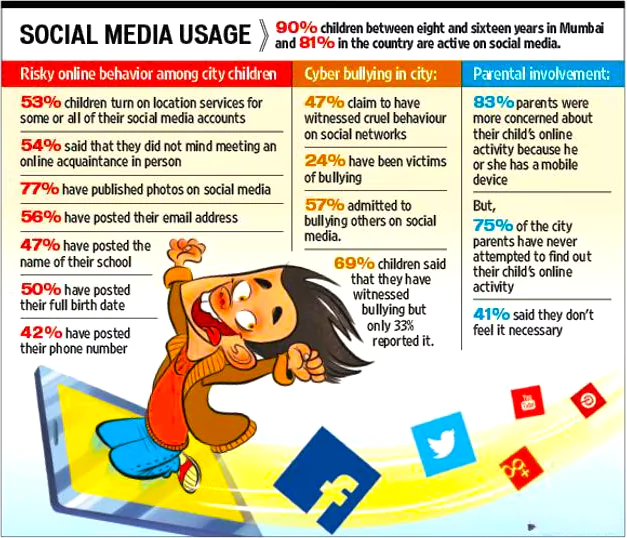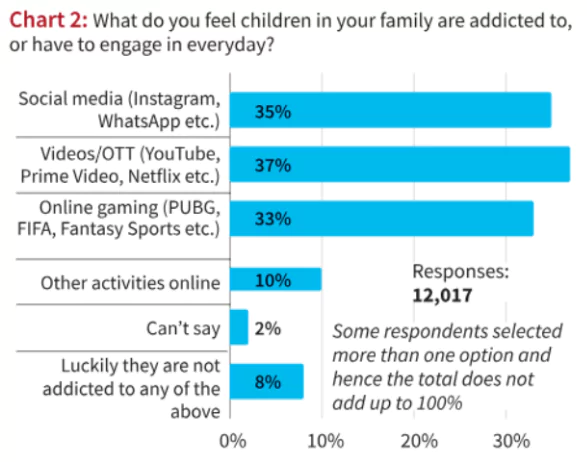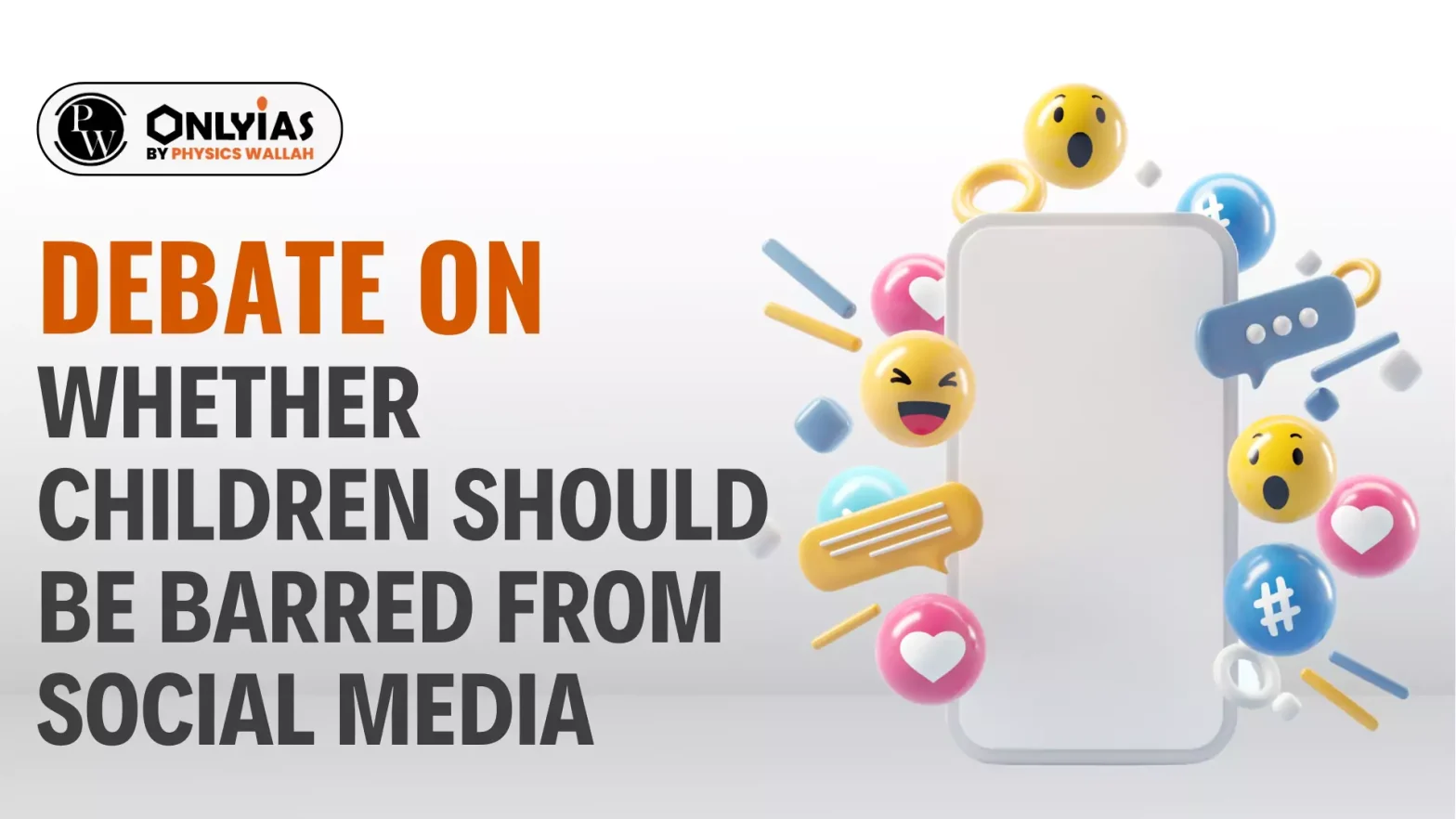The Australian government is planning to legislate a minimum age for children to access social media platforms.
- The Federal government of Australia has committed $6.5 million towards a trial of age verification technology with a view to ban children under 16 years of age to social media accounts.
Ban/Regulation Attempts in India and World
- Karnataka High Court: The Karnataka High Court in an oral order suggested to the Union Government to bring in an age limit for the use of social media.
- India’s Digital Personal Data Protection Act (‘DPDPA’ or ‘Act’):
- Section 9 sets three condition for children’s data under the age of 18
- Obtaining verifiable consent of the parent.
- Processing of personal data to be in alignment with the well-being of a child.
- Ban on tracking or behavioural monitoring of children or targeted advertising directed at children.
- Utah, USA: It became the first US state to adopt laws regulating children’s access to social media.
- Florida Social Media Regulation Law: Social-media companies are required to close accounts believed to be used by minors under 14 or cancel accounts at the request of parents or minors, and all information from the accounts must be deleted.
- Law on Child Artist:
- India: The National Commission for Protection of Child Rights guidelines for child and adolescent participation in the entertainment industry in 2023 require producers to obtain permission from district magistrates before a child can perform in any audio visual content.
- France: As per a law, if a child under the age of 16 is an influencer and earns an income, their parents cannot access that income until the child turns 16.
Enroll now for UPSC Online Course
Reasons for Advocating Bans on Social Media Use
- Cyber Bullying: Young children, especially girls are the easiest target for cyberbullying and Social media platforms act as a catalyst to it.
- Example: The Chinese App TikTok is frequently in news for exposing young girls to cyberbullying.
 Pornography: Children can come across pornographic materials on these social media platforms which can negatively impact their impressionable minds as they risk getting easily addicted to it.
Pornography: Children can come across pornographic materials on these social media platforms which can negatively impact their impressionable minds as they risk getting easily addicted to it.-
- Example: In 2022, India recorded over one thousand cases of Child Pornography with Karnataka reporting the highest numbers
- Addiction and Danger of Falling into Feedback Loops: Social media is designed to exploit users’ attention which poses a risk as young children will easily fall prey to such dopamine-driven feedback loops and get addicted.
- Mental Instability: Increasing online presence is negatively affecting the children’s cognitive development as it isolates them, impacting their socialisation skills which affects their future mental peace and stability.
- A psychology book by Professor Jonathan Haidt called ‘The Anxious Generation: How the Great Rewiring of Childhood Is Causing an Epidemic of Mental Illness’, provides a direct link to the cause for poor youth mental health and wellbeing and the rise of smartphones and social media.
- Violence: Children coming in contact with violent viral content on social media like sexual abusive content , bullying, cuss words, soft porn, hate speech etc can develop violent tendencies amongst themselves.
- Example: Mumbai-based Association of Adolescent and Child Care in India (AACCI) surveyed schools in Mumbai and Gurgaon and found that aggression was on the rise.
- Health Impacts: Social Media Addiction can be manifested as ADHD (Attention Deficit/hyperactivity Disorder),aggression, memory issues, headaches, eye and back discomfort, stress, communication difficulties, lethargy, and even depression.
- The sleep pattern of children is affected due to excessive use of social media.
- Falling Prey to Misinformation: Social media is a hub for false information. Children can be brainwashed easily through propaganda.
- As per a study of UNICEF, only 2% of children and young people have the critical literacy skills they need to judge whether a news story is real or false.
Arguments Against Ban on Social Media Use
- Enforcement Challenges: Bans are challenging to enforce in a digital environment as children can easily bypass these barriers.
- Example: As South Korea passed Cinderella Law banning gaming from midnight to 6:00 a.m there was a rise in identity theft by children to be able to access the gaming platforms.
- Shared Device Usage: In India, as digital literacy is quite low, children help their parents navigate the internet, therefore to expect parents to guide children on safe online usage is not feasible.
- Example: A survey of 10,000 children in Tier 2 and Tier 3 cities and in government schools in Delhi and found out that 80% of children helped their parents navigate online platforms.
- Low Digital Literacy: Using Age Verification Technologies like ID-based verification would be difficult for people who are less literate.
- Example: The NSSO (National Sample Survey Office) data, only 40% Indians knew how to copy or move files on a computer (2021).
- Absolving Accountability: An outright ban will discourage the technology companies in taking responsibility and will have less imperative to design platforms keeping in mind child safety parameters.
- Negation of Positive Digital Engagements: Social media can help children to think critically and engage with people of similar interests building critical socialisation, communication skills for the future with its wide resources
- Example: Children Climate activist like Greta Thunberg used Social Media for propagating her message and build a community of like minded children.
- A Learning Tool: The digital age and social media have created unprecedented opportunities for children and young people to communicate, learn, socialize, and play, exposing them to new ideas and more diverse sources of information.
Check Out UPSC CSE Books From PW Store
Way Forward
Banning the Use of Social Media for Children is not advisable as internet is omnipresent in today’s age, therefore focus should be on certain measures like,
- Adopt Age-Appropriate Design: Follow the U.K’s 2020 Age-Appropriate Design Model, where children have better default settings when they join the platform and are exposed to minimum risk.
- Continuous Feedback on Technology Designs: Platforms should perpetually engage in technology design upgradation as and when any new risk arrives, also there should be a feedback mechanism in place to monitor the changes seen in children’s behaviour.
- A recent study found that platforms such as Meta, Google, TikTok, and Snapchat have made 128 changes related to child safety and privacy.
- Digital Safety Literacy: Children as a part of their core curriculum should be taught Digital Safety Practices like how we teach them safety practices in physical world.
- Discussion on Law on ‘Sharenting’: It is a practice where the parents publicising a large amount of potentially sensitive content about their children on Internet platforms.
- Example: The Assam Police, have been using their social media to warn parents against ‘sharenting’
- Parents as Role Models: Restricting the use of Social Media to children while using it for one’s own amusement will only make the child more resentful and deceptive. Therefore, the parents have to regulate their own use of platforms as well.
- Research shows that when a parent is able to support their child to really maximise the benefits of being online, this also works to mitigate the harms.
- Evidence-Based Policy: High-quality, child-centred research should guide policies and designs by major platforms and develop industry-wide standards defining as to what type of content are appropriate for children of different ages.
- This includes faster research processes that keep pace with emerging digital risks
- Implement Safety-By-Design Principles: The Principle popularised internationally by the Australian eSafety Commissioner is to inculcate safety features into the DNA of technological products and platforms to eliminate sexual, violent and other age-inappropriate content from their feeds.
- To give minors privacy by default
- To provide standardised, easily accessible and well-explained reporting processes across diverse platforms
- To use AI to detect bad actors attempting to interact with children.
Enroll now for UPSC Online Classes
Social Media and Its Use
- About Social Media: It refers to a type of digital technology that facilitate the sharing of ideas and information among its users through text, audio and visuals formats and engagement through virtual networks and communities.
 Example: Facebook, Instagram, X (formerly Twitter), YouTube, whatsapp, linkedIn are some of the notable social media companies. Example: Facebook, Instagram, X (formerly Twitter), YouTube, whatsapp, linkedIn are some of the notable social media companies.
- Users: There are more than 5 billion active users of social media roughly equal to 62% of the world’s population.
- Indian User: A 2022 survey conducted by LocalCircles regarding daily Internet consumption of children aged 9-17 concerning social media, videos/OTT, and online gaming says,
- 61% of urban Indian children devoted an average of 3 hours or longer each day on internet with 46% spending between 3-6 hours, and 15% over 6 hours
- 39% used gadgets for 1-3 hours daily,.
- As per the Annual Status of Education Report (ASER) Report, more than 90% teenagers use social media.
|
![]() 21 Sep 2024
21 Sep 2024

 Pornography: Children can come across pornographic materials on these social media platforms which can negatively impact their impressionable minds as they risk getting easily addicted to it.
Pornography: Children can come across pornographic materials on these social media platforms which can negatively impact their impressionable minds as they risk getting easily addicted to it.